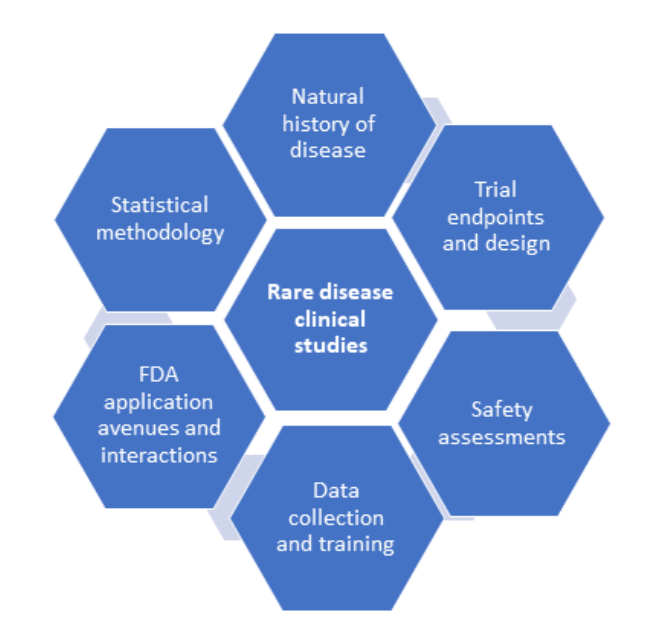Planning a Rare Diseases Clinical Trial? View from United States and Europe
The Orphan Drug Act (ODA) defines a rare disease as a disease or condition that affects less than 200,000 people in the United States (1). According to the European Union (EU), a rare disease is one that affects no more than 1 person in 2000 (2). The comparatively low prevalence rate of rare diseases makes them unattractive for pharmaceutical companies and sponsors to develop therapies, either drugs or medical devices because of the low return on investment that they are expected to yield compared to the monumental cost of the drug development process. Most rare diseases are caused by genetic mutations, and some are due to environmental factors such as diet, smoking, and exposure to toxins. Some types of cancers, autoimmune diseases (Kawasaki disease, Guillain-Barr syndrome), metabolic conditions (Tay-Sachs and Sandhoff diseases), and inherited disorders (cystic fibrosis, muscular dystrophy, and spina bifida) are all rare diseases. Although some rare diseases affect only hundreds to thousands of people globally, they can be severe and life-threatening making it essential to develop appropriate therapies for them in a timely manner. Additionally, some rare diseases have a higher prevalence thus making it more pressing to encourage sponsors to develop treatments.
Rare diseases are also referred to as orphan diseases and drugs developed specifically for their treatment are known as orphan drugs. The term ‘orphan’ designates that very few sponsors are interested in developing treatments for rare diseases and their potential market is limited in size. Initiatives by the US FDA such as the Orphan Drug Act (ODA) provides tax, financial, and market exclusivity benefits to drugs developed for rare diseases. The ODA has led to significant increase in the number of drugs approved for rare diseases since it was passed in the United States in 1983. In 2020, the FDA approved 32 novel drugs and biologics with orphan drug designation which accounted for 58% of all novel drug approvals (3). Other programs such as the Center for Drug Evaluation and Research (CDER) rare diseases team provide training, collaboration with regulatory agencies, and assistance with good scientific practice in the drug development process for rare diseases. The Orphan Drug Designation Program (OOPD) provides grants allowing for priority review of marketing applications for rare diseases. In 2022, CDER launched the new Accelerating Rare disease Cures (ARC) program which helps in increasing and speeding up the development of drugs for rare diseases by partnering with stakeholders and experts to overcome the challenges associated with rare disease clinical trials. Like the FDA, the European Union (EU) has initiated the EU regulation on orphan medicinal products (Regulation EC No 141/2000) and other incentives for the development of therapies for rare diseases such as the European Joint Programmed on Rare Diseases (EJP RD), European Rare disease research Coordination and support Action Consortium (ERICA), and the International Rare Diseases Research Consortium (IRDiRC). All these groups help to coordinate the collaboration of educational institutes, experts, patient advocacy groups, and healthcare systems for understanding and funding research on rare diseases.
Challenges in clinical trials for rare diseases
It is apparent that the relatively smaller population afflicted with rare diseases compared to common diseases poses several problems, particularly in the clinical trial phase of drug development. Some of these include:
Patient recruitment:
the limited population of people affected with rare diseases makes it difficult to recruit enough participants for clinical studies. It may be necessary to conduct extensive screening programs and coordinate several clinical sites globally which can be challenging from a logistic perspective as well as lengthy and expensive. The heterogeneity in the patient population with regards to various demographic and disease-related factors further complicates the analysis and interpretation process.
Need to modify the study design and statistical technique:
smaller sample sizes make it necessary to apply more complex statistical techniques such as Bayesian analysis which is relatively more difficult to perform. Although, randomized clinical trials (RCT) are the gold standard for clinical trial design they may not be applicable for rare diseases due to fewer patients making it necessary to use alternative designs such as case-control studies or group-sequential designs with limited statistical power.
- Limited knowledge of the natural history of the disease and fewer scientific experts makes it hard to select appropriate endpoints for a clinical trial.
Limited global expertize:
lack of knowledge about the disease across geographical locations limits the ability to conduct the disease at multiple sites and further limits patient recruitment and retention.
Pediatric considerations:
Several rare diseases are known to affect children which complicates trial designs along with ethical issues.
- Regulatory decisions: The limited amount of data affects the ability of regulatory agencies to make sound decisions.
Statistical considerations:
Missing data and loss to follow-up induces variability to already fewer data points. Inappropriate or absence of control groups can add bias to the results of clinical studies.
Rare Disease Clinical Studies 101: What you should know
The United States FDA and European Medicines Agency (EMA) has released guidance’s for issues related to drug development for rare diseases and trials in small populations (4, 5). These guidelines highlight various points that need to be considered for clinical studies for rare diseases and should be reviewed thoroughly by sponsors and companies involved in rare disease clinical research. The following figure shows the various considerations from a US and Europe perspective
Figure. Considerations for rare disease clinical studies
- Natural history of disease: In-depth knowledge of the history of progression of diseases is imperative to inform decisions regarding clinical trial design elements, trial duration, endpoint selection, inclusion/exclusion criteria, and factors such as dose selection and schedule, and identification of biomarkers. Natural history studies are particularly useful for rare diseases where information is scarce, and the effect is variable as this will help support drug development. Various types of natural history studies include retrospective studies that utilize information from patient records and prospective studies that analyze new data from patients and may be cross-sectional or longitudinal in design. Information gained from natural history studies is meant to drive the clinical study design plan and is recommended for rare disease drug development.
- Trial endpoints and design: In the case of rare diseases defining a validated endpoint may be difficult due to reasons such as the inability to recruit enough patients and failure to choose an appropriate validated endpoint caused by lack of information about the rare disease. The FDA and EMA recommend the use of surrogate endpoints or biomarkers that have been clinically and analytically validated in place of clinical efficacy endpoints for rare diseases. Analytical validation encompasses sensitivity, specificity of the assay, range, and reproducibility and clinical validation involves the demonstration of a link between the biomarker and clinical endpoint or symptom.
Although, RCTs are the preferred design for all clinical studies evaluating the efficacy and safety of treatments, this design may not always be suitable for rare disease trials due to limited number of patients and unethical considerations in using a placebo group, particularly for life-threatening conditions. In these cases, innovative trial designs such as adaptive designs, sequential designs, n-of-1 trials, and crossover designs may be used which require fewer participants. In certain cases,
non-availability of control groups may allow the use of historical patient registry data. The choice of the trial design should be guided by factors such as the nature of the diseases (chronic or progressive), long-term or short-term control, and symptoms and endpoints.
- Safety assessments: Small-size trials that are mostly carried out for rare diseases limit the safety information that can be gathered from patients, especially in case of chronic or long-term diseases. Regulatory agencies recommend the collation of data from various safety sources such as patient registries, electronic health records, post-marketing studies, preclinical models, and social media to provide more information than that gathered from a trial alone. It is essential however to ensure that the data collected is of high-quality with consistent terminology to allow for development of an accurate risk-benefit profile (4).
- Data collection and training: Data from single case studies may need to be combined to assess the efficacy and safety of treatments for rare diseases based on smaller populations afflicted by the disease as well as significant participant heterogeneity. In this case, it may be necessary to develop standardized protocols and use good documentation practices to ensure uniformity in outcomes to make sound decisions. Training on data collection and good clinical practices (GCP) is also a must as patient data may need to be pooled from multiple sites to ensure adherence to global regulatory requirements. Clinical staff and research coordinators may also require additional training on the disease and clinical symptoms as well as patient management and safety issues to improve consistency particularly for new diseases and measurement techniques and those that affect the Pediatric population. Multisite trials also require the use of Standard Operating Procedures (SOPs) to reduce variability and these documents should be in place before commencing any trial activities.
- Application avenues and interactions: The FDA strongly recommends that sponsors developing treatments for rare diseases be familiar with expedited or accelerated approval programs particularly in cases of serious or life-threatening disorders. Since several rare diseases affect children, it is also important for sponsors to understand the requirements for paediatric populations. Furthermore, FDA encourages sponsors to schedule regular meetings such as pre-IND and meetings after each phase of clinical studies with FDA representatives to receive timely feedback and allow for an efficient drug development process. In Europe, the EMA has compassionate use programs and accelerated assessment programs to bring rare disease treatments to market in a timely manner.
- Statistical methodology: It is necessary to use complex statistical methods and models when dealing with a limited number of data points captured from the smaller number of participants in clinical trials for rare diseases. Bayesian models and nonparametric methods which are often based on several assumptions are used to calculate outputs adding a layer of complexity that can be handled by sensitivity analyzes. Therefore, it is essential that statistical experts be involved in the trial design as well as analysis stage to ensure that the most appropriate models are used.
Although rare disease clinical trials are plagued with problems that are related to a small pool of patients with the disease it is nonetheless important to develop treatments for these diseases as they can be serious. Regulatory agencies have developed guidelines that outline points that should be considered when developing rare disease therapies. In addition to traditional elements of clinical trials, an amalgamation of information from patients, caregivers, and patient advocacy groups is extremely valuable. Real-world evidence and patient engagement are critical elements in rare disease studies and can further expand knowledge about the disease helping in the development of effective treatments and should be seriously considered.
References
- Rare Diseases at FDA | FDA
- Rare diseases (europa.eu)
- Rare Disease Day 2021: FDA Shows Sustained Support of Rare Disease Product Development During the Public Health Emergency | FDA
- Recommendations for the design of small population clinical trials | Orphanet Journal of Rare Diseases | Full Text (biomedcentral.com)






